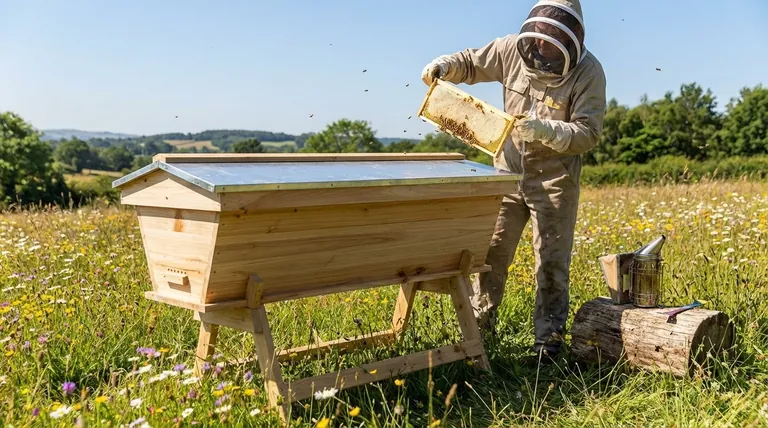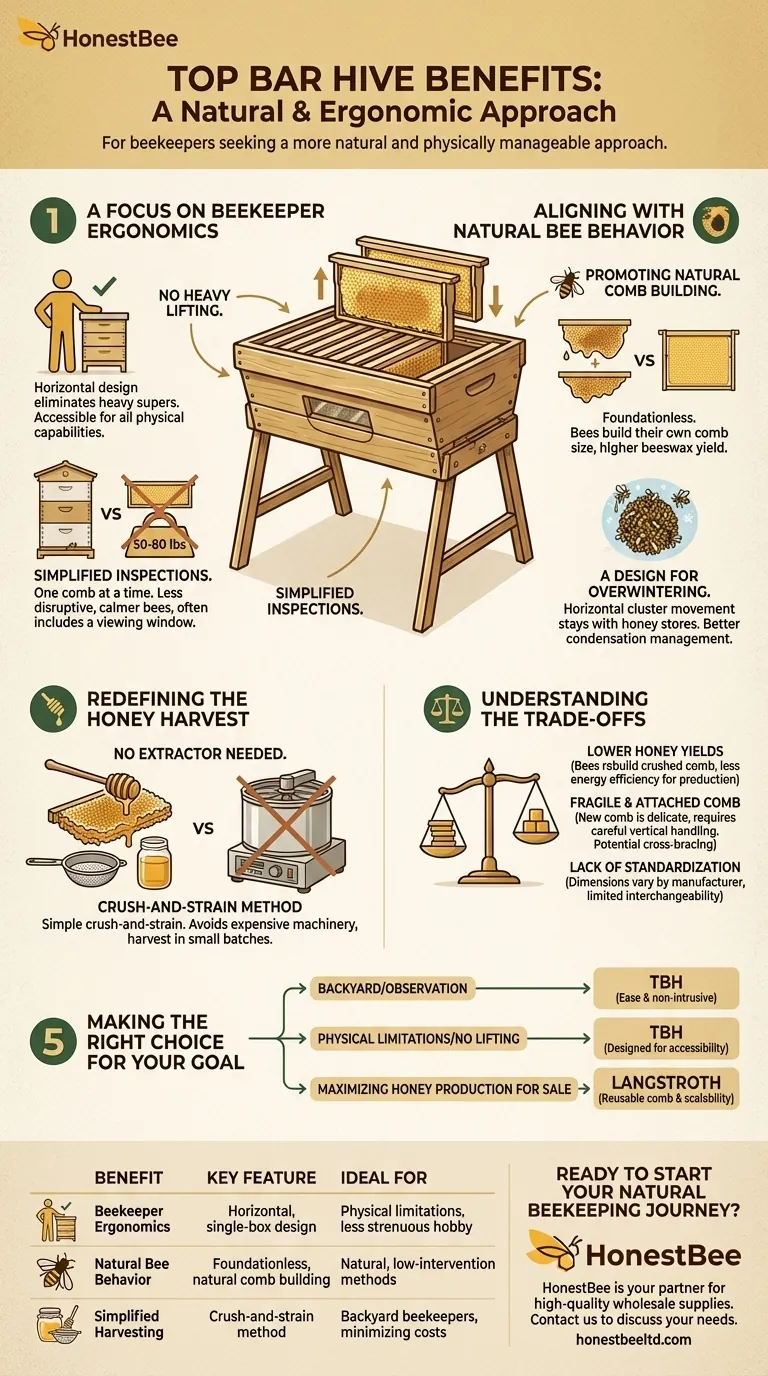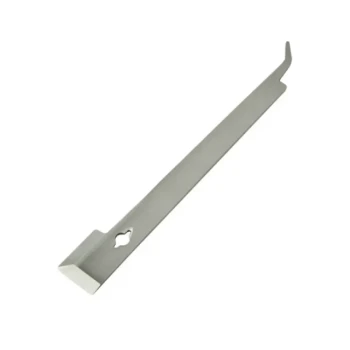For beekeepers seeking a more natural and physically manageable approach, the top bar hive (TBH) offers significant advantages. Its horizontal design eliminates the need for heavy lifting associated with traditional stacked hives, while its management style is less invasive for the bees and simplifies the process of harvesting honey and beeswax without expensive equipment.
The core benefit of a top bar hive is not just its features, but the beekeeping philosophy it represents. It prioritizes beekeeper accessibility and a less intrusive, more natural environment for the colony over the high-volume production goals of conventional hive systems.

A Focus on Beekeeper Ergonomics
One of the most compelling reasons beekeepers choose a TBH is the dramatic reduction in physical strain compared to the standard vertical Langstroth hive.
Eliminating Heavy Lifting
The entire hive is a single, horizontal box, typically set on legs at waist height. All inspections and manipulations happen from the top without ever lifting heavy boxes (supers) that can weigh 50-80 pounds.
This design makes beekeeping accessible to individuals with back problems, physical limitations, or those who simply wish to avoid strenuous labor.
Simplifying Hive Inspections
Inspections are performed one comb at a time by lifting a single top bar. The rest of the colony remains covered and calm.
This is far less disruptive than in a vertical hive, where entire boxes must be removed. As a result, bees in a TBH are often more docile during inspections, requiring less smoke and creating a more pleasant experience for the beekeeper. Many hives also include a viewing window for observation without disturbing the colony at all.
Aligning with Natural Bee Behavior
The top bar hive is designed to mimic the cavities bees naturally choose in the wild, which encourages instinctual behaviors.
Promoting Natural Comb Building
Top bar hives are foundationless, meaning you do not give the bees pre-made wax sheets to build on. Instead, a simple guide on the bar encourages them to build their own comb from scratch.
This gives the bees complete control over the size of the cells they build, which is a core tenet of natural beekeeping. It also results in a higher yield of pure beeswax at harvest.
A Design for Overwintering
In a horizontal hive, the bee cluster can move from one end to the other throughout the winter, staying in contact with their honey stores. This is a more natural progression than moving vertically between boxes.
The design, often combined with a proper hive cover, also helps manage condensation and retain heat, increasing the colony's chances of winter survival.
Redefining the Honey Harvest
Harvesting from a top bar hive is a fundamentally different process that eliminates the need for expensive machinery.
No Extractor Needed
Honey is harvested using the crush-and-strain method. The beekeeper simply cuts the honeycomb from the top bar, crushes it, and allows the honey to strain through a sieve or cheesecloth.
This avoids the significant cost of a centrifugal extractor, which is often a barrier to entry for new beekeepers. It also allows for harvesting in smaller, more manageable batches.
Understanding the Trade-offs
While the benefits are significant, the top bar hive's design comes with important considerations that may not suit every beekeeper.
Lower Honey Yields
Because comb is crushed during harvest, the bees must rebuild it from scratch every time. In a Langstroth hive, extracted comb is returned to the bees, saving them immense energy and leading to higher honey yields. The TBH is not optimized for large-scale honey production.
Fragile and Attached Comb
New, foundationless comb is extremely fragile. Care must be taken to always hold the comb in a vertical position to prevent it from breaking off the bar. Bees may also attach, or cross-brace, their comb to the sloped sides of the hive, making removal difficult if not managed properly.
Lack of Standardization
Unlike Langstroth equipment, which is highly standardized, top bar hive dimensions can vary between manufacturers. This makes it more difficult to interchange parts or source equipment from different suppliers.
Making the Right Choice for Your Goal
Selecting a hive type is the first step in defining your beekeeping journey. The top bar hive is an excellent system when your goals align with its philosophy.
- If your primary focus is backyard beekeeping and bee observation: The TBH is an exceptional choice due to its ease of management and non-intrusive design.
- If you have physical limitations or want to avoid heavy lifting: The TBH is specifically designed to solve this problem and makes beekeeping accessible to everyone.
- If your primary focus is maximizing honey production for sale: The Langstroth hive's reusability of comb and scalability make it the industry standard for a reason.
Choosing a hive is about matching the equipment to your personal beekeeping philosophy and physical capabilities.
Summary Table:
| Benefit | Key Feature | Ideal For |
|---|---|---|
| Beekeeper Ergonomics | Horizontal, single-box design | Beekeepers with physical limitations, those seeking a less strenuous hobby |
| Natural Bee Behavior | Foundationless, encourages natural comb building | Beekeepers focused on natural, low-intervention methods |
| Simplified Harvesting | Crush-and-strain method, no extractor needed | Backyard beekeepers, hobbyists looking to minimize equipment costs |
Ready to Start Your Natural Beekeeping Journey?
If the ergonomic and bee-centric benefits of a top bar hive align with your philosophy, HONESTBEE is your partner. We supply high-quality beekeeping supplies and equipment to commercial apiaries and beekeeping equipment distributors through our wholesale-focused operations.
Let us provide the reliable equipment you need to succeed. Contact HONESTBEE today to discuss your needs.
Visual Guide

Related Products
- Top Bar Beehive for Beekeeping Wholesales Kenya Top Bar Hive
- Long Langstroth Style Horizontal Top Bar Hive for Wholesale
- HONESTBEE Professional Long Handled Hive Tool with Precision Cutting Blade
- HONESTBEE Professional Multi-Functional Hive Tool with Ergonomic Wood Handle
- HONESTBEE Advanced Ergonomic Stainless Steel Hive Tool for Beekeeping
People Also Ask
- What are the labor requirements for a KTBH vs. Langstroth hive? A Guide for Apiary Efficiency
- What are the benefits of extra wax production in top bar hives? A Natural Byproduct for Craft & Efficiency
- Why are hive inspections easier with Top Bar Hives? Achieve a Calmer, Safer Approach to Beekeeping
- How should a beekeeper prepare a top-bar hive for overwintering? A Guide to Ensure Colony Survival
- What are the key features of the Kenyan Top Bar Hive? A Guide to Simpler, Natural Beekeeping



















